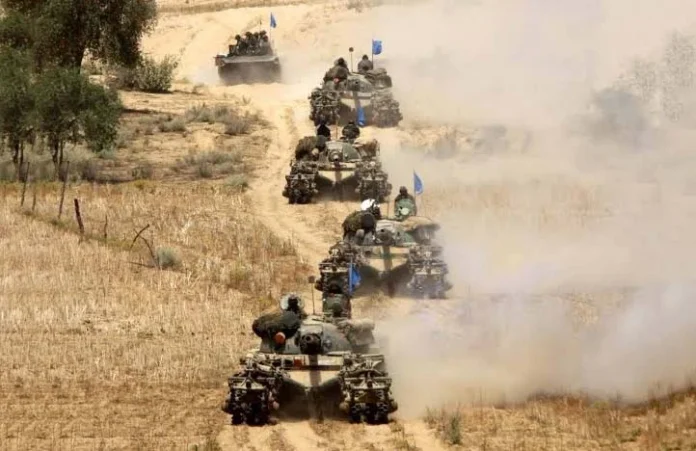Future Market Trend: As per the Global “Armoured Vehicles Market” Report for 2024, the global armoured vehicles market is expected to expand from US$29.9 billion in 2023 to US$36.9 billion in 2028 at a CAGR of 4.3%. This robust growth is mainly driven by global modernisation efforts, rapid technological advancements, the need to address future threats, and the increasing use of armoured vehicles in the Russia-Ukraine conflict.
Europe accounts for 33% while Asia Pacific accounts for 30% of the market share. Asia- Pacific, is expected to exhibit the strongest growth of 9.6% CAGR due to the sharp rise in overall defence spending by India and China. In terms of equipment categories Infantry Fighting Vehicles (IFVs) are expected to account for the largest share (by monetary value) of 29%, followed by Main Battle Tanks (MBTs) – 26%.
India Defence Procurement Policy Reforms
The Indian Government has initiated several key reforms to encourage Make in India in the Defence Sector under Indian Design. These have resulted in the rise in the procurement from private Sector with nearly Rs 17,000 crore worth of contracts placed with the Indian Private Sector with top preference for the Development and Manufacture (IDDM) category. The policy initiatives have resulted in:-
- Enhanced Ease of doing Defence Business – MSMEs have been given a boost with nearly 70% of licences issued to MSMEs with 52% in land systems.
- The Defence Investor Cell was established in Jan 2018 nearly 100 investors facilitated in 100 days.
- De-licencing of 65-70% of items including parts, components etc for manufacturing by private industry.
- Green Channel Policy 2017 which allowed deemed registration status, waiver of pre-despatch inspection, acceptance of stores under supplier’s warranty and renewal of registration on a self-certification basis.
- Opportunity for the Industry to propose products/services Suo Moto.
- Protection for foreign exchange rate variation.
- Simplified Make II. Setting up a Defence Innovation Organisation and task force on AI.
- Setting up of defence industrial corridors.
The Indian government has initiated several key reforms to encourage Make in India in the Defence Sector under Indian Design, which resulted in the rise in the procurement from the private sector with nearly Rs 17,000 crore worth of contracts placed with the Indian Private Sector with a top preference for the Development and Manufacture (IDDM) category
Yet, there exists a gap between expectations and deliverance due to a myriad of reasons including budgetary constraints, lacklustre implementation of policies, pervasive technological backwardness, bureaucratic lethargy, skewed offset policies and evasive foreign direct investment (FDI), among other issues. Above all, there has not been any cultural shift or major restructuring for making the present Make in India initiative and defence procurement outcome-oriented. The process needs to be simplified and made more outcome-oriented with aspects such as ATP included in RFP, quality cum cost-based model, joint inspection and self-certification rather than an archival DGQA organisation etc.
The driver for a vibrant Make in India will be the presence of a robust ecosystem energised and driven by industry-friendly policies, time-stipulated outcomes with accountability and a policy of “Risk Sharing Gain Sharing”. ‘Make in India’ also depends on R&D including industry-driven local R&D and production factors, product technology and manufacturing machine technology. In addition, a vibrant competitive defence industrial base and an eco-system would enable the utilisation and consolidation of existing capabilities in fostering a constructive, long-term partnership with global OEM to be part of the global supply chain and augment the role of Indian private sector companies to develop capabilities and capacities through JV and partnerships. The focus must be on creating an environment that makes Indian firms world competitive and where all enterprises can flourish with levers of IPR in their control. ‘Make in India’ is indeed the enlightened strategic path which requires patience, resilience and support by all stakeholders.

Key MBT Projects
India’s approach to armoured warfare emphasises technological advancements and operational expertise, leveraging indigenous developments and strategic partnerships. Its upgradation and replacement are based on a long-term fleet management philosophy. The stress is on ‘Make in India’ under IDDM.
Future Ready Combat Vehicle (FRCV): The FRCV as the next generation main battle tank is to replace the vintage T-72 Tank Fleet (in service since 1979), which has progressively gone beyond its service life. While the initial fleet of T-72 has been replaced by T90, the later production of approximately 1770 tanks, though upgraded, is not cost-effective to sustain and poses an operational risk due to obsolescence. The FRCVs, with a weight categorisation of 55+/-10% with a high power-to-weight ratio of 27:1 HP/Ton, will have a crew of four. It will be equipped with cutting-edge technologies such as artificial intelligence (AI), drone integration, survivability suites including active protection systems, state of art fire control systems, battlefield management systems, beyond line-of-sight strike capability, advanced communication, state of art optoelectronics, vetronics and enhanced situational awareness. Additionally, features like manned-unmanned teaming capability will enhance the overall operational effectiveness index of the Indian Army (IA) by catering for emerging threats in varied terrain.
There exists a gap between expectations and deliverance due to a myriad of reasons including budgetary constraints, lacklustre implementation of policies, pervasive technological backwardness, bureaucratic lethargy, skewed offset policies and evasive foreign direct investment (FDI), among other issues
The Indian Army is likely to issue a request for proposal (RFP) this year for a project of approximately Rs 57,000 crore to manufacture 1,770 future-ready combat vehicles (FRCVs) in India. Successful development under Make-I would result in acquisition, from a successful Development Agency (DA), through the ‘Buy (Indian-IDDM)’ category with indigenous design and Development and a minimum of 50% IC. The Ministry of Defence, GoI, intends to procure quantity 590 FRCV in the first phase.
Indian Light Tank Zorawar: The broad employment concept of the light tank devolves around its superior mobility (strategic, operational and tactical), versatility, enhanced manoeuvrability (small turning radius, high power-to-weight ratio and low nominal ground pressure), and lethal firepower especially high angle fire cum missile firing ability. The project with state-of-the-art technologies is at an advanced stage of field trials so not being discussed. It will showcase the Indian Private Industry and DRDO collaboration prowess of an indigenous capability.

T-72 and T-90 Possible Upgrade Projects: Opportunities for Aatmanirbharta
T-72 Upgrades: Armament upgrades include TISAS upgrade to TIFCS, higher FPA and lower pitch driver night sight, Commander panoramic sight with FPA 1280×1024 (in3-5 micron range), ATT with Advance Ballistic Computer, improved barrel, tube missile firing capability and superior stabiliser. Automotive upgrades include a 1000HP engine, APU (8-10KW), driver digital panel board and rubberised tracks. Survivability Upgrades include an active protection system, laser warning system, multispectral camouflage Paint and mobile net, RCWS for anti-aircraft gun, and Tank Urban Survival Kit. Additional systems include BMS or a Situational Awareness Module, Software Defined Radio, Environmental Control Unit, integrated IFF, AI integration and drone support/control capability.

T-90 Upgrades: Armament Upgrades- Upgrade Night Fighting Capability& Fire Control System, Digital Ballistic Computer and Advance Fire Control System, Improved Indigenous barrel to fire higher performance APFSDS ammunition of DoP min 600 to 650 mm with matching barrel mean peak pressure sustainability, Improved Armament Stabiliser for higher precision stabilisation of the gun in two planes, upgraded TIESSA with higher FPA camera FPA 1280 X 1024 (in 3-5 micron range), replace the present II sight with TI Uncooled fusion technology Day Night sight with an FPA 640 x 512, pitch < 25 microns, Commander Panoramic Sight with independent stabilisation of the field of view in two planes comprising TV and thermal imaging channels and a laser rangefinder, multi-target tracker system. Automotive Upgrade – 1200HP to 1500HP Engine. Auxiliary Power Unit (10 to 12 KW), Driver Digital Information and Warning System, Rubberised Tracks with the present system, Automatic Gear Shifter. Survivability Upgrade- Remote Control Weapon System two-axis stabilised for12.7mm anti-aircraft gun, Tank Urban Survivable Kit (TUSK) as an optional add-on upgrade be offered, Active Protection System (AFV Protection and Counter Measure System for T90) against both chemical energy and kinetic energy attacks, Heat and Signature Management Systems to ensure low visibility detection by enemy systems across the entire wavelength bands. Additional Systems – Environmental Control Unit (ECU), Intelligent Power Management System, Individual Under Water Breathing Apparatus, Integrated Identification of Friend or Foe System integrated with a situational awareness suite, Software Defined Radio (SDR based MANETs and AI integrated systems.
-The author is a PVSM, AVSM, VSM has had an illustrious career spanning nearly four decades. A distinguished Armoured Corps officer, he has served in various prestigious staff and command appointments including Commander Independent Armoured Brigade, ADG PP, GOC Armoured Division and GOC Strike 1. The officer retired as DG Mechanised Forces in December 2017 during which he was the architect to initiate process for reintroduction of Light Tank and Chairman on the study on C5ISR for Indian Army. Subsequently he was Consultant MoD/OFB from 2018 to 2020. The Officer is a reputed defence analyst, a motivational speaker and prolific writer on matters of military, defence technology and national security.The views expressed are personal and do not necessarily carry the views of Raksha Anirveda.
The author, a PVSM, AVSM, VSM has had an illustrious career spanning nearly four decades. A distinguished Armoured Corps officer, he has served in various prestigious staff and command appointments including Commander Independent Armoured Brigade, ADG PP, GOC Armoured Division and GOC Strike 1. The officer retired as DG Mechanised Forces in December 2017 during which he was the architect to initiate process for reintroduction of Light Tank and Chairman on the study on C5ISR for Indian Army. Subsequently he was Consultant MoD/OFB from 2018 to 2020. He is also a reputed defence analyst, a motivational speaker and prolific writer on matters of military, defence technology and national security. The views expressed are personal and do not necessarily carry the views of Raksha Anirveda






